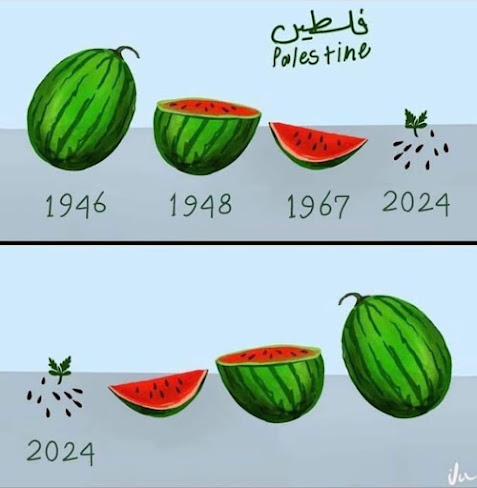 |
| Artworks using these four colors were banned by Israeli law in the 1980s. This ban ended in 1993. |
 |
| Early 1900's photo of watermelon vendors in #Gaza #Palestine! |
 |
Watermelon market outside Jaffa Gate at the base of the Citadel walls, #Jerusalem, #Palestine...Circa 1900's |
 |
| Protest for Palestine |
After Israel occupied the West Bank and the Gaza Strip in 1967, it banned the Palestinian flag, which was lifted after the signing of the Oslo Peace Accords in 1993. They are routinely confiscated by the Israeli police.[5] Israel's restriction on the Palestinian flag were criticized by Amnesty International as an attempt to legitimize racism, adding that the Palestinian flag has been used for the past decades as "a symbol of unity and resistance to Israel’s unlawful occupation".
The use of the watermelon as a Palestinian symbol has appeared in the wake of Israel's restrictions of Palestinian flags.
,%20a%20Palestinian-Jordanian%20artist%20in%20England,%20depicts%20a%20slice%20of%20watermelon%20on%20a%20Hebron%20plate.%20.jpg) |
| Beesan Arafat (@beesanarafat on Instagram), a Palestinian-Jordanian artist in England, depicts a slice of watermelon on a Hebron plate. |
The use of the watermelon as a Palestinian symbol has come as a response to Israel's confiscation of Palestinian flags.

Some people have a country they live in. We have a country that
lives within us. This collection of essays is a journey into the heart
and soul of a Palestinian who shares personal stories, reflections, and
feelings about Palestine and the diaspora. Through these writings, you
will discover a country that is not just a place on a map but a living
presence in the minds and hearts of its people. A SEED IN THE FRUIT OF PALESTINE ESSAYS BY MIKE ODETALLA
Thanks Mike!


No comments:
Post a Comment